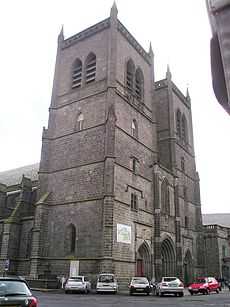Roman Catholic Diocese of Saint-Flour
| Diocese of Saint-Flour Dioecesis Sancti Flori Diocèse de Saint-Flour | |
|---|---|
|
| |
| Location | |
| Country | France |
| Ecclesiastical province | Clermont |
| Metropolitan | Archdiocese of Clermont |
| Statistics | |
| Area | 5,726 km2 (2,211 sq mi) |
| Population - Total - Catholics |
(as of 2010) 157,000 137,300 (87.5%) |
| Information | |
| Denomination | Roman Catholic |
| Rite | Roman Rite |
| Established | 20 February 1317 |
| Cathedral | Cathedral of St Peter and St Flour in Saint-Flour, Cantal |
| Patron saint | Saint Flour of Lodeve |
| Current leadership | |
| Pope | Francis |
| Bishop | Bruno Grua |
| Metropolitan Archbishop | Hippolyte Simon |
| Emeritus Bishops | René Séjourné Bishop Emeritus (1990-2006) |
| Website | |
| Website of the Diocese | |
The Roman Catholic Diocese of Saint-Flour is a Diocese of the Latin Rite of the Roman Catholic Church in France. The diocese comprises the department of Cantal. Erected in 1317, the diocese is currently the suffragan of the Archdiocese of Clermont, after transferral from the Archdiocese of Bourges in 2002. The episcopal see is located in Saint-Flour, Cantal.
The current bishop is Bruno Grua, who was appointed in March 2006.
History
The diocese is named after St. Florus (Flour), who is said to have been the first Bishop of Lodève and to have died at Indiciat (later Saint-Flour) while evangelizing Haute-Auvergne. These traditions have been the subject of numerous discussions. In two documents concerning the foundation of the second monastery of St-Flour, drawn up in 1013 and 1031, and in a letter written to Pope Urban IV in 1261 by Pierre de Saint-Haon, prior of Saint-Flour, St. Flour is already considered as belonging to the Apostolic times, and the Speculum sanctorale of Bernard Gui in 1329 relates at length the legend of this "disciple of Christ". Marcellin Boudet believes it more likely that St. Flour lived in the fifth century, and that it was he who attended the Council of Arles in 450 or 451.
At the close of the tenth century there was already a monastery at Indiciat. A local seigneur, Astorg de Brezons, surnamed "the Red Bull", gave this monastery to Odilo, Abbot of Cluny, and the donation was confirmed by Pope Gregory V (996–99). Amblard de Brezons, his nephew, surnamed "le Mal Hiverné", seized the monastery and destroyed all of it except the church. Amblard and Astorg, from 1010 to 1013, gave this church and its fief to St. Peter's at Rome, together with the monastery of Sauxillages, governed by Odilo; but later Amblard considered this donation as void, and constructed a fortress, a remnant of which is now the sacristy of the cathedral, on the site of the old monastery; afterwards Amblard, seized with remorse at Rome, between 1025 and 1031 gave back to Odilo all he possessed, and a large monastery was again founded. Pope Urban II, after the Council of Clermont (1095), consecrated the church of this new monastery. The church collapsed in 1396, and no remains of it exist. Pope Callistus II passed some time there.
In August, 1317, Pope John XXII detached Haute-Auvergne from the bishopric of Clermont and raised St-Flour to the rank of a bishopric, the first ordinary of which was his chaplain Raymond de Montuéjols. Among his successors were Pierre d'Estaing (1361–67), afterwards Archbishop of Bourges and cardinal in 1370; Louis-Siffrein-Joseph de Salamon (1820–29), former counseiller-clerc to the Parliament of Paris, who during the French Revolution had secretly acted in France as the pope's agent, a rôle concerning which he has left very important memoirs.
Juridically speaking suppressed and immediately re-established by the Holy See in accordance with the Napoleonic Concordat of 1801, the boundaries of the re-established diocese being now aligned to coincide with those of the civil département of Cantal. The diocese established in the area by the Civil Constitution of the Clergy in 1790 had indeed been of Cantal, which was sometimes referred to at that period as the diocese of Saint-Flour, after its episcopal seat. The Abbey of Aurillac is located in the diocesan territory.
Ordinaries
- Jean-Eléonor Montanier de Belmont † (5 Jul 1802 Appointed – 1 May 1808 Died)
- Louis-Siffrein-Joseph de Salamon † (6 Mar 1820 Appointed – 11 Jun 1829 Died)
- François-Marie-Edouard de Gualy † (8 Jul 1829 Appointed – 18 Mar 1833 Appointed, Archbishop of Albi)
- Jean-Pierre-Marie Cadalen † (24 Jun 1833 Appointed – 17 Apr 1836 Died)
- Frédéric-Gabriel-Marie-François de Marguerye † (1 Apr 1837 Appointed – 15 Oct 1851 Appointed, Bishop of Autun)
- Jean-Paul-François-Marie-Félix Lyonnet † (15 Oct 1851 Appointed – 24 Jun 1857 Appointed, Bishop of Valence)
- Pierre-Antoine-Marie Lamouroux de Pompignac † (24 Jun 1857 Appointed – 23 May 1877 Died)
- François-Antoine-Marie-Ambroise-Benjamin Baduel † (15 Jun 1877 Appointed – 16 May 1891 Died)
- Jean-Marie-François Lamouroux † (2 Apr 1892 Appointed – 12 Jul 1906 Died)
- Paul-Augustin Lecoeur † (13 Jul 1906 Appointed – 18 Mar 1942 Died)
- Henri-Marie-Joseph Pinson † (12 Jan 1943 Appointed – 18 Apr 1951 Died)
- Gabriel Auguste François Marty † (6 Feb 1952 Appointed – 14 Dec 1959 Appointed, Coadjutor Archbishop of Reims)
- Maurice-Jean-Fernand-Alexis Pourchet † (28 Mar 1960 Appointed – 6 May 1982 Retired)
- Jean Cuminal † (6 May 1982 Appointed – 25 Jul 1990 Appointed, Bishop of Blois)
- René Pierre Louis Joseph Séjourné (13 Sep 1990 Appointed – 16 Jan 2006 Retired)
- Bruno Grua (31 Mar 2006 Appointed – )
